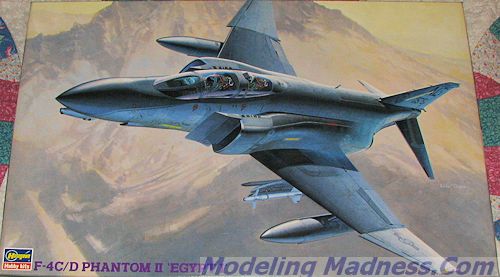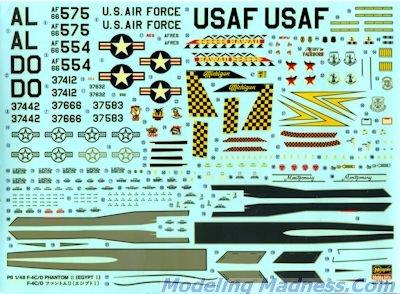
Hasegawa 1/48 F-4C/D 'Egypt I'
| KIT #: | 07211 |
| PRICE: | 3200 yen |
| DECALS: | Four options |
| REVIEWER: | Scott Van Aken |
| NOTES: | Limited Reissue (1996) |

| HISTORY |
In USAF service the F-4 was initially designated the F-110 Spectre prior to the introduction of the 1962 United States Tri-Service aircraft designation system. The USAF quickly embraced the design and became the largest Phantom user. The first air force Phantoms in Vietnam were F-4Cs from the 555th "Triple Nickel" Tactical Fighter Squadron, which arrived in December 1964.
Unlike the U.S. Navy and U.S. Marine Corps, which flew the Phantom with a Naval Aviator (pilot) in the front seat and a Naval Flight Officer as a radar intercept officer (RIO) in the back seat, the USAF initially flew its Phantoms with a rated Air Force Pilot in the back seat. While the rear pilot (GIB, or "guy in back") could fly and ostensibly land the aircraft, he had fewer flight instruments and a very restricted forward view. The Air Force later assigned a rated Air Force Navigator qualified as a weapon/targeting systems officer (later designated as weapon systems officer or WSO) in the rear seat instead of another pilot.[ However, all USAF Phantoms retained dual flight controls throughout their service life.
On 10 July 1965, F-4Cs of the 45th Tactical Fighter Squadron, 15th TFW, on temporary assignment in Ubon, Thailand, scored the USAF's first victories against North Vietnamese MiG-17s using AIM-9 Sidewinder air-to-air missiles. On 26 April 1966, an F-4C from the 480th Tactical Fighter Squadron scored the first aerial victory by a U.S. aircrew over a North Vietnamese MiG-21 "Fishbed". On 24 July 1965, another Phantom from the 45th Tactical Fighter Squadron became the first American aircraft to be downed by an enemy SAM, and on 5 October 1966 an 8th Tactical Fighter Wing F-4C became the first U.S. jet lost to an air-to-air missile, fired by a MiG-21.
Early aircraft suffered from leaks in wing fuel tanks that required re-sealing after each flight and 85 aircraft were found to have cracks in outer wing ribs and stringers. There were also problems with aileron control cylinders, electrical connectors, and engine compartment fires.
Although the F-4C was essentially identical to the Navy/Marine Corps F-4B in flight performance and carried the AIM-9 Sidewinder missiles, USAF-tailored F-4Ds initially arrived in June 1967 equipped with AIM-4 Falcons. However, the Falcon, like its predecessors, was designed to shoot down heavy bombers flying straight and level. Its reliability proved no better than others and its complex firing sequence and limited seeker-head cooling time made it virtually useless in combat against agile fighters. The F-4Ds reverted to using Sidewinders under the "Rivet Haste" program in early 1968, and by 1972 the AIM-7E-2 "Dogfight Sparrow" had become the preferred missile for USAF pilots. Like other Vietnam War Phantoms, the F-4Ds were urgently fitted with radar homing and warning (RHAW) antennae to detect the Soviet-built SA-2 Guideline SAMs.
From the initial deployment of the F-4C to Southeast Asia, USAF Phantoms performed both air superiority and ground attack roles, supporting not only ground troops in South Vietnam but also conducting bombing sorties in Laos and North Vietnam. As the F-105 force underwent severe attrition between 1965 and 1968, the bombing role of the F-4 proportionately increased until after November 1970 (when the last F-105D was withdrawn from combat) it became the primary USAF tactical ordnance delivery system. In October 1972 the first squadron of EF-4C Wild Weasel aircraft deployed to Thailand on temporary duty. The "E" prefix was later dropped and the aircraft was simply known as the F-4C Wild Weasel.
Sixteen squadrons of Phantoms were permanently deployed between 1965 and 1973, and 17 others deployed on temporary combat assignments. Peak numbers of combat F-4s occurred in 1972, when 353 were based in Thailand. A total of 445 Air Force Phantom fighter-bombers were lost, 370 in combat and 193 of those over North Vietnam (33 to MiGs, 30 to SAMs, and 307 to AAA).
| THE KIT |
 What
you have here is your standard 1988 F-4C/D boxing with the addition
of a one-piece canopy and the later F-15 style centerline tank. This
includes 1988 decals and 1988 instructions with an addendum sheet
for the canopy.
What
you have here is your standard 1988 F-4C/D boxing with the addition
of a one-piece canopy and the later F-15 style centerline tank. This
includes 1988 decals and 1988 instructions with an addendum sheet
for the canopy. Instructions
are well done and provide Gunze paint references. The markings
options are the same as the 1988 kit with the box art plane from the
160 TFS, Alabama ANG in the then new Hill Grey II scheme. Next is
199 FIS, Hawaii ANG plane in the rarely seen Hill Grey I scheme. In
the Euro I scheme is a double MiG killer from the 89 TFS, USAF
Reserves from Dayton, Ohio. Finally, four options from the 171 FIS,
Michigan ANG in overall ADC Grey. This unit had nose art or names on
all of its F-4Cs and is quite popular with modelers. The large decal
sheet is well done and includes not only stencils but the large
intake and fuselage walk areas. I have my doubts about the viability
of these old decals, but one never knows until one tries them.
Instructions
are well done and provide Gunze paint references. The markings
options are the same as the 1988 kit with the box art plane from the
160 TFS, Alabama ANG in the then new Hill Grey II scheme. Next is
199 FIS, Hawaii ANG plane in the rarely seen Hill Grey I scheme. In
the Euro I scheme is a double MiG killer from the 89 TFS, USAF
Reserves from Dayton, Ohio. Finally, four options from the 171 FIS,
Michigan ANG in overall ADC Grey. This unit had nose art or names on
all of its F-4Cs and is quite popular with modelers. The large decal
sheet is well done and includes not only stencils but the large
intake and fuselage walk areas. I have my doubts about the viability
of these old decals, but one never knows until one tries them.
| CONCLUSIONS |
| REFERENCES |
http://en.wikipedia.org/wiki/F-4D_Phantom_II
August 2014
My thanks to me for this one.
If you would like your product reviewed fairly and fairly quickly, please contact the editor or see other details in the Note to Contributors.
Back to the Previews Index Page